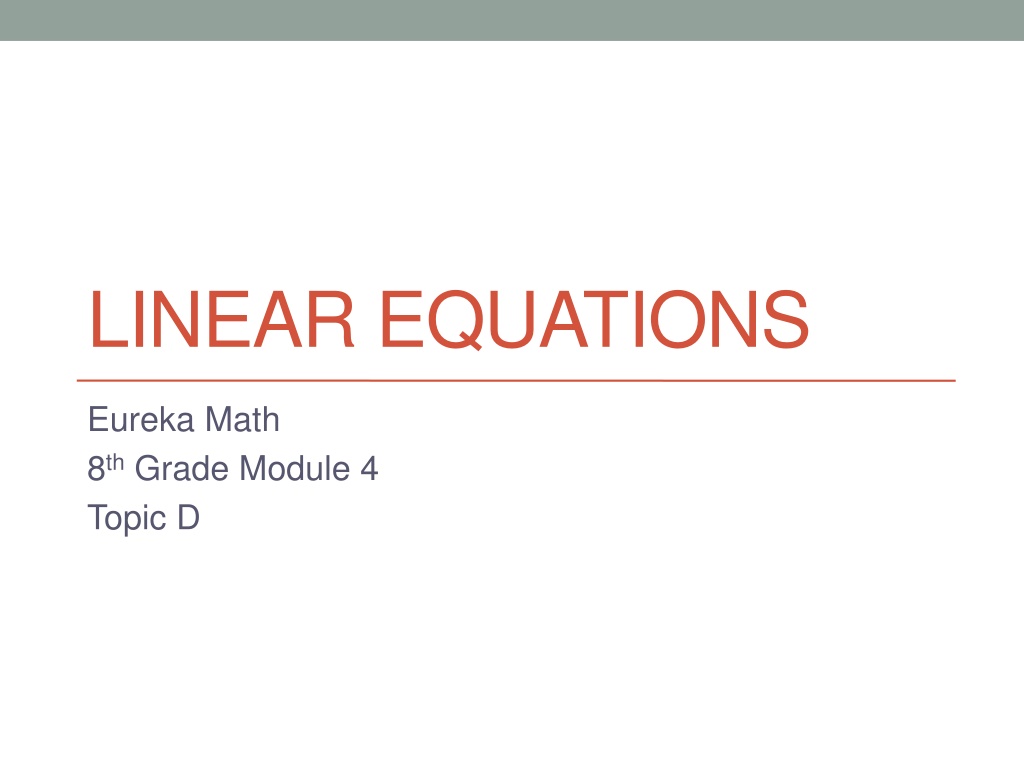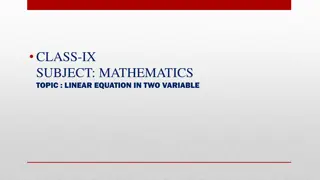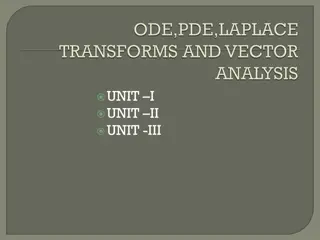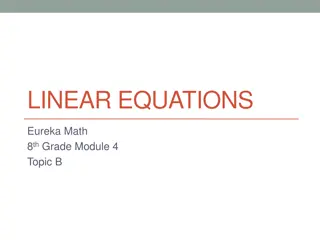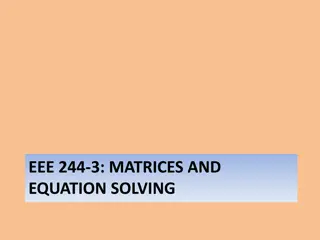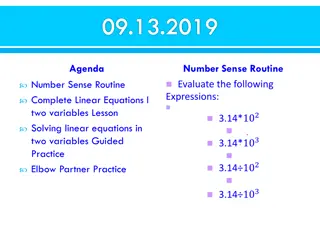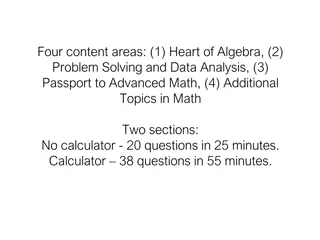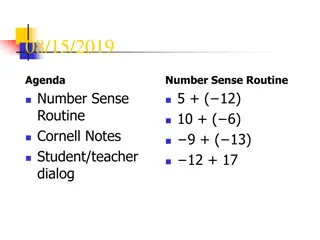Exploring Linear Equations in 8th Grade Math
Dive into Module 4, Topic D of Eureka Math's 8th-grade curriculum focusing on linear equations. The lesson covers systems of equations, solving problems involving constant speeds, and practicing linear equation concepts. Explore examples, workshops, and more to enhance your understanding of this fundamental algebraic concept.
Download Presentation

Please find below an Image/Link to download the presentation.
The content on the website is provided AS IS for your information and personal use only. It may not be sold, licensed, or shared on other websites without obtaining consent from the author. Download presentation by click this link. If you encounter any issues during the download, it is possible that the publisher has removed the file from their server.
E N D
Presentation Transcript
LINEAR EQUATIONS Eureka Math 8thGrade Module 4 Topic D
LESSON 24 Opener, Notes, examples(3), workshop
Opener Complete problems 1-3 in pairs
Notes Systems of Equations A System of Equations (aka Simultaneous Equations) is a situation when a pair of equations work together. A system can have one solution, no solutions, or infinitely many solutions (just like in lesson 7). The goal is to determine the exact coordinates of the point where the lines intersect. This is a solution to both equations and the solution to the system. { Notation: equation 1 equation 2
Example 1 Sandy and Charlie run at constant speeds. Sandy runs from their school to the train station in 15 minutes, and Charlie runs the same distance in 10 minutes. Charlie starts 4 minutes after Sandy left the school. Can Charlie catch up to Sandy? The distance between the school and the station is 2 miles.
2 8 ? = 15? + 15 ? =1 5? The ?-intercept of Sandy s run shows the distance she has run at the moment that Charlie starts walking. The point of intersection is when they have traveled the same distance at the same time (they meet).
Example 2 Randi and Craig ride their bikes at constant speeds. It takes Randi 25 minutes to bike 4 miles. Craig can bike 4 miles in 32 minutes. If Randi gives Craig a 20-minute head start, about how long will it take Randi to catch up to Craig? Write the equations for each.
? =1 8? +5 4 25? 2 ? =
Workshop Must Do May Do Lesson 24 cw #4-5 Khan academy PARCC tasks Linear equation practice Make up work Slope practice Exponents review
Warm Up Rewrite these equations into slope-intercept form (look in lesson 17 for a refresher) 3? + 2? = 10 5? ? = 12
Warm Up Rewrite these equations into standard form (look in lesson 20 for a refresher) ? =3 ? = 5? 10 4? + 6
LESSON 25 Workshop, notes
Workshop Must Do May Do Lesson 25 cw #1-5 Khan academy PARCC tasks Lesson 25 cw #6 Finish lesson 24 cw Linear equation practice Slope practice Exponents review
Notes Systems of Equations A System of Equations (aka Simultaneous Equations) is a situation when a pair of equations work together. A system can have one solution, no solutions, or infinitely many solutions, like in lesson 7. The goal is to determine the exact coordinate (solution) where the two lines intersect. This is also a solution to both equations. { Notation: equation 1 equation 2 Systems of equations typically have ONE SOLUTION because lines intersect at one point. But, If the lines are parallel (same slope, different y-intercept) they will never intersect NO SOLUTION If lines are the same (same slope and same y-intercept) they always intersect INFINITE SOLUTIONS
LESSON 26 Review notes, workshop
Notes Systems of Equations A System of Equations (aka Simultaneous Equations) is a situation when a pair of equations work together. A system can have one solution, no solutions, or infinitely many solutions, like in lesson 7. The goal is to determine the exact coordinate (solution) where the two lines intersect. This is also a solution to both equations. { Notation: equation 1 equation 2 Systems of equations typically have ONE SOLUTION because lines intersect at one point. But, If the lines are parallel (same slope, different y-intercept) they will never intersect NO SOLUTION If lines are the same (same slope and same y-intercept) they always intersect INFINITE SOLUTIONS
Workshop Must Do May Do Lesson 26 cw #1-9 Khan academy PARCC tasks Lesson 25 cw #6 Finish lesson 24 cw Linear equation practice Slope practice Exponents review Make up work
LESSON 27 Notes, examples(3), workshop
Warm Up/Entry Determine the nature of these systems of equations. Do they have one, zero, or infinite solutions? 3? + 4? = 5 ? = 3 9? + 6? = 3 3? + 2? = 1 7? + 2? = 4 ? ? = 5 4? + 1
Notes Solving Systems of Equations By substitution: 1) Solve one equation so that is says either y= something or x=something (if it already does, you can skip this step) 2) Substitute the entire equation from step 1 into the other equation for that variable 3) Solve for the one variable that remains by: a) Distributing b) Simplifying c) Using properties of equality 4) Substitute back into one equation to find the other.
Example 1 ? = 3? + 5 ? = 8? + 3 First, does this system have a solution?
Example 2 First, does this system have a solution? ? = 7? 2 2? 4? = 10
Example 3 4? = 26? + 4 ? + 1 = 11? First, does this system have a solution?
Workshop Must Do May Do Lesson 27 cw #1-6 Khan academy PARCC tasks Finish lesson 24-26 cw Linear equation practice Slope practice Exponents review Note sheet Folder organize
LESSON 28 Warm Up, Notes, examples(3), workshop
Warm Up Explain how you would solve these systems of equations. ? = 6? + 7 ? = 10? + 2 ? = 7? 2 2? 4? = 10
Notes Solving Systems of Equations By substitution: 1) Solve one equation so that is says either y= something or x=something (if it already does, you can skip this step) 2) Substitute the entire equation from step 1 into the other equation for that variable 3) Solve for the one variable that remains by: a) Distributing b) Simplifying c) Using properties of equality 4) Substitute back into one equation to find the other variable. By Elimination: Works best when both equations are in standard form (or can easily be put in standard form) 1) Scale the equations so that the coefficients on one variable will cancel out. 2) Add or subtract the entire equations 3) Solve for the one remaining variable 4) Substitute back into one equation to find the other
Example 1 6? 5? = 21 2? + 5? = 5
Example 2 2? + 7? = 5 4? 2? = 14
Example 3 7? 5? = 2 3? 3? = 6
Workshop Must Do May Do Lesson 28 cw #1-6 Khan academy PARCC tasks Finish lesson 27 cw Linear equation practice Slope practice Exponents review Note sheet Folder organize
Warm Up Which method for solving would you use for each system? 2? 9? = 7 ? + 9? = 5 ? = 5? 19 3? + 11 = ? 4? 3? = 8 ? + 7? = 4 ? + ? = 3 6? + 6? = 6
Notes/Summary Graphing is, in many ways, the easiest way to solve systems of equations, but the point will only be an estimate. Substitution works best when one already equation has x= or y= or it can easily be written that way. Elimination works best if both equations are in standard form.
LESSON 29 Examples(4), workshop
Example 1 The sum of two numbers is 361, and the difference of the numbers is 173. What are the numbers?
Example 2 There are 356 8th graders at Euclid Middle School. 34 more than four times the number of girls is equal to half the number of boys. How many boys and how many girls are there?
Example 3 A family member has some five-dollar bills and one-dollar bills in her wallet. Altogether, she has 18 bills and a total of $62. How many of each bill does she have?
Example 4 A friend bought 2 boxes of pencils and 8 notebooks and it cost $11. He went back and bought his brother 3 boxes of pencils and 5 notebooks for $11.25. How much would 7 notebooks cost?
Workshop Must Do May Do Exit ticket 27 and 28 Lesson 29 cw #1-3 Khan academy PARCC tasks Linear equation practice Slope practice Exponents review Note sheet Folder organize
LESSON 30 & 31 Notes, Examples, workshop
Celsius & Fahrenheit Two different scales for temperature (American and metric) 9 5 This led to the formula: F = C + 32 5 9 This led to the formula: C = (F 32)
Examples 1) Change 37 C into degrees Fahrenheit. 2) Change 50 F into degree Celsius
Pythagorean Theorem So far we have shown with two proofs and much practice that if a triangle is a right triangle, then a2 + b2 = c2 The converse of this is also true: If a2 + b2 = c2, then a triangle is a right triangle.
Pythagorean Triples Any 3 positive integers that satisfy a2 + b2 = c2 are called Pythagorean Triples. For example: 3, 4, 5 is the most known. It works because 32 + 42 = 52 (9 + 16 = 25) Multiples of Pythagorean Triples also work: 6, 8, 10 is a triple and so is 9, 12, 15, etc. The other well-known triple is: 5, 12, 13
Pythagorean Triples { You can generate a Triple using the system of equations: x+ y =t s x- y =s t Where s and t are any integers and t > s c b,a The solution will always be: b And a, b, c will be a Pythagorean Triple.
Example Let s = 1 and t = 2 { { x+ y =2 x+ y =t 1 s x- y =1 x- y =s 2 t
Workshop Must Do May Do Lesson 30&31 cw Khan academy PARCC tasks Linear equation practice Slope practice Exponents review Note sheet Folder organize
The Test Content 6a: write system (29) 6b: Solve system (27-29) 7: Equation from points (16) 8a: Graph from slope- intercept (18) 8b: Graph from standard (19) 9ab: Y-intercept (17) 9c: Write system and equations (18, 24, 29) 9d: Solution on graph (24- 25) 1a: Count slope (15) 1b: Calculate slope (16) 1c: understand slope (15-16) 2a: Compare rates (11, 24) 2b: Write equation (1, 2, 11, 24) 2c: Graph from equation (18) 2d: Slope from graph (11, 15) 3a-c: Solve systems (27-28) 4: Type of solution (7, 25-26) 5ab: Type of solution (7, 25-26)
